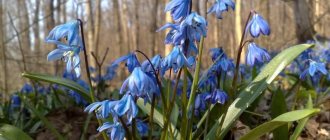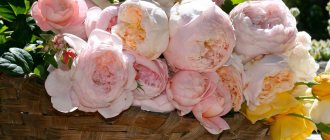Appearance
Snowdrop flowers are white and have green spots at the very edge of the petals (plants of other colors are not snowdrops). The elegant bell-shaped shape of galanthus is given by the structure of its petals: the flower has six petals, three of which are outer (longer), three are inner (shorter).
This flower has few leaves, the shape is narrow, flat, dark green or gray-green. Galanthus leaves are usually about 1 cm wide. The plant's bulb is round in shape, from which only one flower grows, and small: about three centimeters in diameter.
Feeding
While the snowdrop is actively growing, it needs liquid fertilizing with inorganic potassium phosphate fertilizers without nitrogen, which can cause excessive leaf growth. Potassium is needed for the formation of healthy winter-hardy bulbs, and phosphorus is necessary for flowering. Active growth requires a lot of water. Usually, watering is not needed in early spring, but if suddenly the spring is dry, then the grower will have to provide the plant with moisture. Watering small bulbous plants is not burdensome - they are very resistant to drought and will not die, but will not be tall. After flowering, snowdrops do not require care until the end of the season.
So, easy care of caring for an unpretentious and rare flower will bring joy to gardeners and preserve the snowdrop. The Red Book is needed as a document that controls its protection.
Popular varieties
According to various classifications, there are 12-25 varieties in the Galanthus genus. This discrepancy is due to the fact that some plants are too similar to each other and botanists argue whether to classify them as a separate species or as an already registered one. Let's look at the most famous and cultivated varieties.
Caucasian snowdrop
The plant is common in the mountain forests of Transcaucasia. The yellowish bulb reaches a length of 4 cm and a width of 2 cm. Dark green flattened leaves with a waxy coating rise above it. The length of the plant is 18 cm. The peduncle, about 6 cm high, bears a snow-white bell. The outer bracts are obovate in shape, slightly curved, their length is about 2 cm. Inside there are wedge-shaped petals, they are half as long. On the petals, above the notch, a green spot is visible. Blooms in March.
Snowdrop white
This species is the most common in Russia for cultivation. It is actively growing and occupying adjacent territories. In mid-March, 2 narrow bluish-green leaves grow from the soil. Fragrant bells consist of elongated white petals. Closer to the pharynx there is a yellow spot on the perianth. Flowering lasts throughout April. This species became the basis for several hybrid varieties:
- Flore Peno is a double variety with greenish inner petals;
- Lutescens is a capricious plant with miniature pale flowers;
- Lady Elphinstone is a double variety with yellow spots on the inner petals;
- Arnot - long white bracts hide a short flower with green spots;
- Viridapicis - blooms already at the end of February with large flowers, green spots are at the ends of all petals.
Snowdrop latifolia
The plant is found in the alpine foothills and is most suitable for the northern regions. Above a large bulb 4-5 cm long are erect dark green leaves. During the flowering period, their length is 16 cm, and later reaches 20-25 cm. A white bell is located on a peduncle 15-20 cm long. The oval outer petals hide the short ovoid ones. A shapeless green spot is visible on the flower. There is no notch on the petals. Flowering occurs in May-June for 20 days. There is no fruiting, it reproduces vegetatively.
Blue snowdrops are also popular among people . However, this plant does not belong to the genus Galanthus. Most often, this name refers to scillas from the Asparagus family. They are quite similar in external structure and early flowering, but are not related to snowdrops.
Lily saranka
The habitat of this cold-resistant species is Southern Europe and Siberia. Under natural conditions, the saranka lily grows in deciduous forests and on the edges. The height of its stem is 80 cm. The flowers are purple in color and have dark spots. Lily blooms in mid-summer. Blooming flowers exude a sweet aroma. Limiting factors include deforestation, grazing, harvesting for bouquets and digging up bulbs for transfer to a personal plot.
Reproduction methods
The most convenient way to propagate snowdrops is to separate the young bulbs. Each year, 1-3 additional bulbs are formed on the mother plant. After 3-5 years, when the clump has grown sufficiently, it can be divided. In August-September, after the foliage has completely dried, snowdrops can be replanted. The bush is carefully separated by hand, trying not to damage the thin rhizome. The bulbs are planted to a depth of 6-8 cm individually or in small groups.
Seed propagation is considered more difficult, although it allows you to get many plants at once. It is necessary to allow the seeds to ripen completely. Sowing is done immediately after harvesting, as they quickly lose their germination capacity. Sow the seeds in open ground to a depth of 1-2 cm. Seedlings bloom in 3-4 years. The place should be chosen shady and windless.
About the choice of planting material
It is better to buy bulbs in July-September and plant them in the fall. At this time, the plant is at rest. When purchasing, you need to pay attention to the condition of the planting material. The bulbs should be dense to the touch, with intact shells, without mechanical damage or putrefactive manifestations. If they have overgrown roots and stems, this will require prompt planting. Small (dried and not affected by mold) cuts on the scales of the onion are acceptable, but there should be no damage to the bottom. Planting material with the top cut off but the bottom not damaged is considered viable. You should not purchase broken or crumpled bulbs - they may have internal damage or areas of rot. It is impossible to grow a good snowdrop from such planting material. The Red Book does not give recommendations on the cultivation of species, it only determines the status and area of growth. The most favorable conditions for breeding will be exactly where the natural habitat is located.
Galanthus bulbs do not tolerate prolonged drying. There is no need to keep them outdoors for more than a month. If the time for planting has not yet arrived, then the bulbs must be sprinkled with sawdust or small shavings and placed in a cotton bag or perforated plastic bag. The shelf life will last 2-3 months.
Features of care
Location. Miniature snowdrops grow easily and do not require careful care. However, they are very picky about the location and composition of the soil. They should be planted under trees. The place should be fairly shady in summer, but well warmed up by the sun in early spring. Ideal planting under tall deciduous trees such as walnut, cherry, chestnut and others.
Temperature. The plant tolerates even severe frosts and does not need additional shelter. In summer, excessive overheating can lead to the death of the bulbs. For this you will need shade from the trees.
The soil should be nutritious and moist, but without stagnant water. Loose substrates with the addition of compost or humus are suitable. In clay soil you need to add additional sand.
Snowdrops only need watering Usually they get enough water from melted snow and spring rains.
Fertilizer. During the growing season and flowering, it is worth fertilizing monthly. Choose phosphate and potassium liquid complexes. Excess nitrogen causes foliage to grow greatly, which is subsequently often affected by fungal diseases.
Diseases and pests. With regular stagnation of water in the soil, snowdrops suffer from fungal diseases (rust, powdery mildew, chlorosis). To protect rare plants, you need to choose the right soil composition and location. Periodically, it is recommended to replant and treat the bulbs with a fungicide. Natural pests of galanthus are slugs, caterpillars, bulb nematodes, and mice. To prevent rodents and slugs, coarse sand and shell rock are scattered around the lawn, and sods with grass are placed around the perimeter. Treatment with an insecticide will save you from small insects.
Planting and caring for snowdrops
- Flowering: in the first half of spring, sometimes already from the end of March.
- Planting: planting bulbs in the ground - from July to November.
- Lighting: bright sunlight.
- Soil: loose, moist, well-drained. Rain or melt water should not stagnate on the site.
- Watering: only needed if the winter was snowless and spring came without rain.
- Fertilizing: mineral complexes with low nitrogen content.
- Reproduction: mainly by children separated from the mother bulb, less often by seeds.
- Pests: caterpillars of moths, nematodes, slugs, moles and mice.
- Diseases: rust, gray rot, chlorosis.
Read more about growing snowdrops below.
Usage
By planting snowdrops on your property, you can not only decorate the area, but also propagate an endangered plant. Galanthus are good in group plantings in a rock garden or in the middle of a lawn. If you distribute them evenly under the trees, you can get a continuous carpet, like in a forest.
In flower beds, snowdrops are placed in the foreground, along with other shade-tolerant plants. When the first flowers fade, attention will turn to the neighbors. These can be scillas, corydalis, primroses, lungworts, peonies, hostas and even ferns.
Bouquets of snowdrops look great in a vase without any decoration, but can be combined with deciduous or other flowering specimens. You shouldn’t pick a lot of flowers and collect them in the forest, because the snowdrop is included in the Red Book of Russia. It is better to admire their delicate beauty on the street.
Interestingly, the plant contains galantamine. This alkaloid was isolated in the middle of the 20th century. It is used in traditional medicine and is part of drugs to combat Alzheimer's disease and other diseases of the nervous system.
First flowers of spring
The forest snowdrop has long been a symbol of spring, purity, youth and freshness, and also says that you need to rejoice in both the present and the future, and drive away memories of failures from your heart - so it is not surprising that these gentle, beautiful flowers are extremely popular.
Snowdrops, the first flowers of spring, or as the Greeks called them, galanthus (“milk flowers”) belong to the genus of perennial herbs of the amaryllis family, are early small-bulbous plants and are listed in the Red Book.
Snowdrops grow in the wild in forests: in the center and south of the European continent, there are many of them on the coast of the Black and Caspian Seas, as well as in Asia Minor. These flowers prefer sunny areas, although they grow without problems in the shade, but they do not tolerate areas with stagnant water.
Useful properties of Ivan tea254494.35
Interesting facts about snowdrops
1. The scientific name of snowdrops is galanthus . It is formed from the Latinized Greek words gála and ánthos - “milk flower”.
2. In the language of flowers, snowdrop means comfort and hope .
3. Snowdrops grow in Central and Southern Europe, on the Black Sea coast, on the western coast of the Caspian Sea and in Asia Minor. And most of all species of this flower can be found in the Caucasus. There are 16 species of snowdrops living there.
4. Snowdrops contain the organic compound galantamine, which was first isolated from the bulbs of Voronov’s snowdrop and is included in the list of “Vital and Essential Medicines.” Galantamine is used to treat residual effects of poliomyelitis (spinal paralysis), movement disorders associated with central nervous system disorders and other diseases.
5. Despite the fact that the snowdrop appears in the spring, it is able to withstand ten-degree frost. It is helped in this by a kind of “cover” of thin hairs at the base of the stem.
6. In 2012, a bulb of a rare snowdrop, whose flowers have yellow spots, was sold on the online auction eBay for a record sum of 725 pounds sterling (about 34,500 rubles). Previously, in 2011, a snowdrop bulb, which did not have the usual splashes of green found in other species, went under the hammer for £350.
7. The term "galantophilia" means collecting snowdrops. One of the largest collections of snowdrops grows in the west of the English county of Gloucestershire, in the town of Colesbourne Park. Naturalist Henry John Elvis began collecting these delicate plants more than 130 years ago; one of the snowdrop species he found in Turkey, “Elvis’s snowdrop,” was even named after him.
8. Snowdrop bulbs are poisonous.
9. Some species of snowdrops are included in the Red Book . According to the law, only those that were grown in greenhouses and have the appropriate certificate can be sold.
10. The snowdrop is a relative of the narcissus. They belong to the same amaryllis family. The snowdrop blooms immediately after the snow melts, starting in January, and blooms until April.
Video
Possible problems in growing snowdrops
Compliance with all planting and care rules does not guarantee that the flowers will grow beautiful and healthy. Pests and diseases characteristic of plants can interfere with growth.
Diseases
True snowdrops can carry diseases such as rust, chlorosis or gray mold. Usually they affect the appearance of the plant, so if a gardener notices defects in flowers, he immediately checks his suspicions about possible diseases. On the modern market you can find a large number of products that can resist such diseases.
Pests
Caterpillars, nematodes, moles, mice and slugs are considered dangerous pests for galanthus. Rodents tend to chew on bulbs and thereby slow down the growth process or even destroy the plant. To combat parasites, it is worth treating the perennial with preparations available at any flower shop.
The leaves may contain parasites from which the plant must be protected.
Snowdrops are the very first spring flowers. They can grow both in their natural environment, for example, in the forest, and in the garden. It is important to provide them with the necessary conditions and care, and then they will delight everyone with their snow-white beauty for several years.
Violet, cut
On the territory of Russia, the species is found in Khakassia, Siberia and the Far East. The height of the plant does not exceed ten centimeters. The violet has no stems, and the feathery leaves are on short petioles. Peduncles rise above the leaves. The size of purple flowers is up to 15 mm. In the southern regions, violets bloom in June, and in the northern regions - not earlier than August. The species is distributed on sandy and pebbly shores. The plant does not reproduce well: the seeds do not ripen every year. The reason for the population decline is numerous floods, livestock grazing, and human economic activity. To preserve cut violets, regular collection of seed material and monitoring of the situation in the natural places where it grows is required.











